Every day, we are bombarded by headlines about the threat of emerging and re-emerging diseases, such as MERS, Ebola, Zika virus or antibiotic-resistant bacteria. Most physicians and medical professionals in Europe and North America, taught in the spirit of Western Medicine, focus on treating symptoms of diseases using medications or surgical procedures. Therefore, they might not be aware or consider the complexities and the ecological relationships underlying such diseases, connecting e.g. human health and animal health. A potential solution is to expose future medical professional to disease ecology and the One Health concept, which recognizes that the health of humans is connected to the health of animals and the environment, and facilitates the collaboration of physicians, veterinarians, ecologists and other scientists to solve the interdisciplinary problems that these and other diseases pose. In this post, I will tell you about my recent personal experience doing this, and hopefully convince those of you in faculty positions to do the same.
The earlier future medical professionals can be exposed to disease ecology and the concepts of One Health, the better they can integrate it into their overall medical training. This quarter, I had the privilege of teaching a capstone course in Disease Ecology at the Department of Biology at Eastern Washington University, where I’m an Assistant Professor. Capstone courses are specifically designed for graduating seniors in our undergraduate BSc in Biology program, and combine a rigorous upper-level specialized content with group projects where students have to demonstrate their ability to conduct independent research at a professional level, preparing them for jobs after graduation. The students in my course, all very bright, happened to be mostly preparing for careers as medical professionals, either physicians, physician assistants, or dentists. They mostly had prior training in both anatomy and physiology, as well as microbiology and ecology. Therefore, they were the ideal set of students to teach disease ecology to. I pushed them hard early in the quarter to choose relevant group projects, and I also involved them in hands-on disease ecology by taking them as a class to collect ticks by dragging at the study site of my graduate student. In terms of content, I chose the only infectious disease ecology book available on the market, “Infectious Disease Ecology”, edited by Rick Ostfeld and Valerie T. Eviner, as the textbook for the class.
The textbook, while it was a good resource, turned out to be a mixed bag. The book itself is a proceedings compilation of contributed talks at a conference at the Cary Institute in 2005. The authors of the book chapters include a list of well-renowned contemporary researchers in disease ecology, and provide an impressive array of conceptual ideas and case studies from human, wildlife, livestock and plant disease systems. The book focuses on the effect of ecosystem complexities on disease dynamics, the effect of diseases on ecosystem processes and management implications and applications of the lessons of disease ecology. However, the dizzying diversity of the topics in the chapters is also reflected in the style and level of these chapters. While some of the chapters are entertaining and easy to read (e.g. the one by Jim Porter on coral disease), others chapters are quite complicated and difficult to read. Students without prior exposure to advanced mathematics, ordinary differential equations, and dynamical systems theory will have difficulty digesting some of the chapters without additional support, that is up to the instructor to provide. Since this book is not an official textbook, it does not come bundled with Powerpoint slides ready for lectures, which meant I had to read the book chapters, take notes, and create these lectures myself, amounting to a lot of prep time. Towards the end of the quarter, I started asking groups of students to present on the book chapters themselves, increasing their interaction with the book chapters, as well as alleviating my workload. In addition to the lectures, I tried to create active and hands-on exercises to help process and interpret the more complex material and concepts in the book chapters as much as possible. In general, the textbook was helpful in pulling together diverse case studies to highlight important epidemiological and ecological concepts, which is an inherent difficulty in disciplines such as disease ecology.
In addition to immersing themselves in disease ecology through the textbook, the students had to design, propose, conduct, analyze, interpret, and publish independent research projects that were relevant to disease ecology. Relevance was defined rather loosely, such that any studies on hosts, pathogens, vectors at multiple locations and/or across time would qualify. First of all, the students surprised me by their eagerness and excitement to design specific studies that they had a particular interest in. They took the initiative and researched the literature on their subjects, and designed their experiments with minimal assistance. They were mostly independent and self-reliant, and only came to me and my grad student for help when it was absolutely necessary (e.g. advanced data analysis). I deliberately designed the structure of the group projects to mimic professional scientific research as much as possible, with the inclusion of peer review at every step of the way. Students had to peer review initial draft proposal of their projects, as well as drafts of their final papers in pieces, such as the Methods, the Results, as well as the Introduction and Discussion sections. In addition, students participated in an outreach activity where they showed their projects to local high school students – including an activity where the visiting students could race ticks climbing up on a tick drag against each other; as well as see how fast they can move mosquito larvae between cups using a bulb pipette. As an instructor, it was very rewarding to see my graduating seniors show their projects and explain their work to these high school students. They were also exposed to how disease ecology is practiced in a local context through guest presentations by the staff at the Zoonotic Disease Program at the Washington State Department of Health as well as the Department of Fish and Wildlife. They then finished their projects by completing their final papers and showcasing their projects to each other as well as the entire department in the form of posters. Below, you can read a short summary of each research project accompanied by some pictures of the students participating in the projects.
Antibiotic Resistant Bacteria in the Cheney Wastewater Treatment Process
Kathryn Leitz, Emily Ramseth, Hillary Kinsman, JJ Vela, Sierra Gulla, Jojo Junhusadee
Antib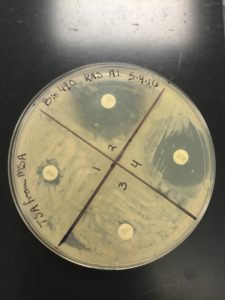 iotic resistant bacteria are becoming a major health concern nationwide, especially when they are “superbugs” and are resistant to multiple strong antibiotics. Bacteria have more opportunity to become
iotic resistant bacteria are becoming a major health concern nationwide, especially when they are “superbugs” and are resistant to multiple strong antibiotics. Bacteria have more opportunity to become
resistant the more often they are unnecessarily exposed to antibiotics, which is too often the case due to the over-prescription and overuse of antibiotics. These antibiotic resistant bacteria are then capable of contaminating sewage and the environment. We wanted to see how well the Wastewater Treatment Plant in Cheney, WA, where Eastern Washington University is located, is removing potentially pathogenic bacteria from wastewater. We tested influent (everything coming into the plant before treatment), RAS or returned-activated sludge (partially treated bio-solid material), effluent (the treated water portion of the wastewater being released into the environment), and EcoGreen Compost (the treated end product bio-solid material being sold to consumers for gardening purposes). Each sample was plated multiple times in the microbiology lab at Eastern Washington University, and random colonies of bacteria were chosen to test for antibiotic resistance against 4 types of antibiotics. The antibiotics we chose were streptomycin, tetracycline, ciprofloxacin, and chloramphenicol. We found no bacterial growth at all in the effluent, which was a good result and what we were looking for. However, we did find that 25% of the bacteria in the influent, 31% of the bacteria in the RAS, and 31% of the bacteria in the compost were antibiotic resistant to one or more of the antibiotics tested. We followed up by identifying the antibiotic resistant bacteria and found that most were common enterics or bacteria found in the environment. Although no “superbugs” were found, the bacterial species we identified (e.g. Listeria) could still cause disease in those with a compromised immune system or other susceptible populations, such as small children or the elderly.
Distribution of ticks related to distance from wetlands at Turnbull Laboratory for Ecological Studies
Ashley Brown, Nicole Christenson, Amy Erickson, Anne Fleming and Karen Kenny
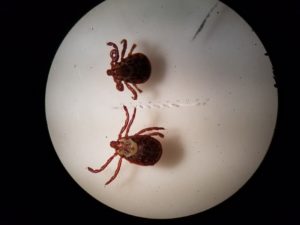 Ticks are a common vector for disease and can be found in most outdoor and wildlife settings. Chances are that if you have ever been hiking, camping, or just simple trail walking, you have encountered these bothersome pests. Dermacentor andersoni is the most common species of tick found at Turnbull National Wildlife Refuge and have been shown to carry the bacteria Rickettsia rickettsi which is responsible for causing Rocky Mountain Spotted fever. We choose to study the distribution of this species to better assess any possible risk factor to public health. Our study looked at nine different transects at varying distances from wetlands and other variables such as wildlife tracks, temperature, and humidity. The goal was to find out if there is any relationship between the number of ticks found and how close they were to wetlands. We collected ticks on a weekly basis for four weeks at each transect. After collection we sexed and identified the species, all of which were D. andersoni. A multiple regression analysis was ran and we found that there was a significant negative correlation to distance from wetland (more ticks near wetlands) and to the presence of animal tracks. There was almost no correlation with temperature and humidity. Our study is important because we now have an understanding of the specific environments in which these disease vectors can be found. With this knowledge we can predict in which areas we could reduce the risk of the public coming in contact with potentially infected ticks by avoiding the areas where ticks are most prevalent.
Ticks are a common vector for disease and can be found in most outdoor and wildlife settings. Chances are that if you have ever been hiking, camping, or just simple trail walking, you have encountered these bothersome pests. Dermacentor andersoni is the most common species of tick found at Turnbull National Wildlife Refuge and have been shown to carry the bacteria Rickettsia rickettsi which is responsible for causing Rocky Mountain Spotted fever. We choose to study the distribution of this species to better assess any possible risk factor to public health. Our study looked at nine different transects at varying distances from wetlands and other variables such as wildlife tracks, temperature, and humidity. The goal was to find out if there is any relationship between the number of ticks found and how close they were to wetlands. We collected ticks on a weekly basis for four weeks at each transect. After collection we sexed and identified the species, all of which were D. andersoni. A multiple regression analysis was ran and we found that there was a significant negative correlation to distance from wetland (more ticks near wetlands) and to the presence of animal tracks. There was almost no correlation with temperature and humidity. Our study is important because we now have an understanding of the specific environments in which these disease vectors can be found. With this knowledge we can predict in which areas we could reduce the risk of the public coming in contact with potentially infected ticks by avoiding the areas where ticks are most prevalent.
Effects of temperature and CO2 on bacteria causing coral bleaching
Melissa Johnson, Petey Pace and Myshelle Williams
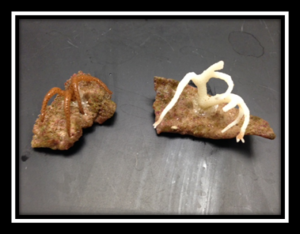 Existence of coral reef populations are threatened by global climate changes due to an increase in surface water temperatures and oceanic acidification making coral species more susceptible to disease outbreaks. These factors ultimately contribute to the decline and future extinction of coral reef systems in our oceans. We hypothesized that as surface water temperatures increase and pH decreases, the corals will be more vulnerable to bleaching events and other diseases and will become unable to maintain successful growth patterns, which will eventually result in coral death. Over the course of our six-week study, we attempted to replicate the global climate changes in temperature and pH of our oceans in order to help predict the future survivorship of coral reef ecosystems. Throughout the testing period, disease and recovery of the corals continuously occurred showing how susceptible and vulnerable these animals are to change within their environment. We had the greatest response of bleaching within the treatment tank replicating year 2100 indicating that the extinction of stony, hard corals, such as the Seriatopora and Galaxea, is extremely likely to occur by this period in time. Other coral species classified as soft corals, such as the Gorgonacea and Zoanthid, are more likely to persist in despite future climate changes because they feed primarily by photosynthesis and on phytoplankton, with the aid of zoothanthelle. Diseases among coral reef systems in response to climate change pose a threat to the ove
Existence of coral reef populations are threatened by global climate changes due to an increase in surface water temperatures and oceanic acidification making coral species more susceptible to disease outbreaks. These factors ultimately contribute to the decline and future extinction of coral reef systems in our oceans. We hypothesized that as surface water temperatures increase and pH decreases, the corals will be more vulnerable to bleaching events and other diseases and will become unable to maintain successful growth patterns, which will eventually result in coral death. Over the course of our six-week study, we attempted to replicate the global climate changes in temperature and pH of our oceans in order to help predict the future survivorship of coral reef ecosystems. Throughout the testing period, disease and recovery of the corals continuously occurred showing how susceptible and vulnerable these animals are to change within their environment. We had the greatest response of bleaching within the treatment tank replicating year 2100 indicating that the extinction of stony, hard corals, such as the Seriatopora and Galaxea, is extremely likely to occur by this period in time. Other coral species classified as soft corals, such as the Gorgonacea and Zoanthid, are more likely to persist in despite future climate changes because they feed primarily by photosynthesis and on phytoplankton, with the aid of zoothanthelle. Diseases among coral reef systems in response to climate change pose a threat to the ove
rall richness of marine populations within our oceans. Being able to predict the effects of climate change on coral reef systems is critical for understanding future problems in order to formulate plans to help conserve and safe our coral marine ecosystems from going extinct.
Comparative Larvicidal Effects of Gliricidia sepium (Madre de Cacao) seeds on Culex pipiens (house mosquito)
Tasha Anisimov and Krystal Jensen
Developing new classes of effective insecticides and larvicides is a
continued chall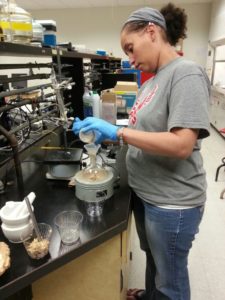 enge in order to counter the wave of emerging and re-emerging mosquito-borne diseases such as West Nile virus, dengue virus, chikungunya virus, and Zika virus. We used water soluble polar extracts, non-polar extracts, and pulverized seeds of the Madre de Cacao tree (Gliricidia sepium) to test for larvicidal effects against the northern house mosquito Culex pipiens. The use of Gliricidia sepium leaf extract had been previously documented as an effective larvicide on mosquitoes of the same species. We applied five treatments of (1) water soluble (polar) extracts, (2) fatty acid (non-polar) and honey emulsifier extract, (3) pulverized seeds, (4) a primary control of distilled water and (5) a secondary control of honey water to two sets of larval stages (1st or 2nd instars vs. 3rd or 4th instars). We then compared the mortality rate of Culex pipiens after 12 hours and then again after 72 hours following treatment administration. Statistically significant difference was found in the mortality rate of larvae between the above treatments, with up to 60% mortality rates, confirming that Gliricidia sepium would be a good candidate for use as an organic pesticide. Nevertheless, further research would need to be conducted to determine whether or not it is environmentally friendly and if it is safe for human use.
enge in order to counter the wave of emerging and re-emerging mosquito-borne diseases such as West Nile virus, dengue virus, chikungunya virus, and Zika virus. We used water soluble polar extracts, non-polar extracts, and pulverized seeds of the Madre de Cacao tree (Gliricidia sepium) to test for larvicidal effects against the northern house mosquito Culex pipiens. The use of Gliricidia sepium leaf extract had been previously documented as an effective larvicide on mosquitoes of the same species. We applied five treatments of (1) water soluble (polar) extracts, (2) fatty acid (non-polar) and honey emulsifier extract, (3) pulverized seeds, (4) a primary control of distilled water and (5) a secondary control of honey water to two sets of larval stages (1st or 2nd instars vs. 3rd or 4th instars). We then compared the mortality rate of Culex pipiens after 12 hours and then again after 72 hours following treatment administration. Statistically significant difference was found in the mortality rate of larvae between the above treatments, with up to 60% mortality rates, confirming that Gliricidia sepium would be a good candidate for use as an organic pesticide. Nevertheless, further research would need to be conducted to determine whether or not it is environmentally friendly and if it is safe for human use.
Are Spokane Crayfish Taken Over by Nematodes?
Kelsi Andersen, Callie Barker, Alexander Fruci, Julia Ho, Daniel Mercado and Nikolus Richey
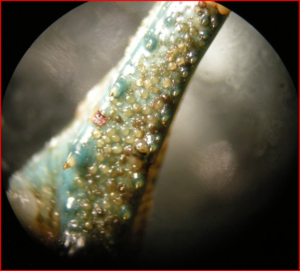 We conducted a study with the aim of discovering whether there were sections of the Spokane River in Eastern Washington that held crayfish with greater amounts of nematodes. What caught our interest in this study was when our Professor told us about nematodes found in crayfish while a summer study of crayfish was being performed. We found in the literature that nematodes are believed to transmit pathogens to aquatic species. The Washington Department of Health has labelled portions of the river as unsafe to eat from due to high heavy metal levels. We were curious how this could affect the rates of nematodes in crayfish along the Spokane River, and how eutrophication fit in to the picture. Traps were set at three locations along the Spokane River, using cat food as bait, in May of 2015. In the most upstream location 3 greater crayfish were caught using 6 traps in 2 capture days. In the middle location 4 medium to small crayfish were captured using 6 traps in 2 capture days. In the downstream portion no crayfish were caught while using 8 traps in one capture day. The traps were set in the evening and left overnight as crayfish move primarily in low light. Water samples were tested for phosphate, nitrate and dissolved oxygen. Crayfish were sacrificed and brought to Eastern Washington University for examination. Upon examination, we found that there were larval sacs located on the ventral surface of the claws on all crayfish. The crayfish that had the greater number of these cocoons was in the middle site. One small crayfish had a very large number of these. Upon closer examination and research we found that these small sacs were branchiobdellida larvae. Once the crayfish were opened, they were examined for nematodes but none were found. Connective tissue was examined under a microscope and digestive contents were viewed. We quantified the number of brachiobdellida larvae on one claw of each crayfish to find whether there was a pattern. We found that in the middle region which is in downtown Spokane, brachiobdellid cocoons were most dense. Phosphate and nitrate levels were found to be between 0-0.25ppm, and 0-0.5ppm at each site. Dissolved oxygen moved from 12.6mg/L- 10.7mg/L- 10.4mg/L as we moved from the upriver location to the downriver locations. We hypothesize that nematodes were not found in the crayfish at this time due to the cold temperatures and the fact that there are not many crayfish in the River this time of year. Future research should be done to find whether nematodes living in crayfish of the Spokane River are greater in some portion of the river, and the potential effect of the brachiobdellid larvae on crayfish fitness.
We conducted a study with the aim of discovering whether there were sections of the Spokane River in Eastern Washington that held crayfish with greater amounts of nematodes. What caught our interest in this study was when our Professor told us about nematodes found in crayfish while a summer study of crayfish was being performed. We found in the literature that nematodes are believed to transmit pathogens to aquatic species. The Washington Department of Health has labelled portions of the river as unsafe to eat from due to high heavy metal levels. We were curious how this could affect the rates of nematodes in crayfish along the Spokane River, and how eutrophication fit in to the picture. Traps were set at three locations along the Spokane River, using cat food as bait, in May of 2015. In the most upstream location 3 greater crayfish were caught using 6 traps in 2 capture days. In the middle location 4 medium to small crayfish were captured using 6 traps in 2 capture days. In the downstream portion no crayfish were caught while using 8 traps in one capture day. The traps were set in the evening and left overnight as crayfish move primarily in low light. Water samples were tested for phosphate, nitrate and dissolved oxygen. Crayfish were sacrificed and brought to Eastern Washington University for examination. Upon examination, we found that there were larval sacs located on the ventral surface of the claws on all crayfish. The crayfish that had the greater number of these cocoons was in the middle site. One small crayfish had a very large number of these. Upon closer examination and research we found that these small sacs were branchiobdellida larvae. Once the crayfish were opened, they were examined for nematodes but none were found. Connective tissue was examined under a microscope and digestive contents were viewed. We quantified the number of brachiobdellida larvae on one claw of each crayfish to find whether there was a pattern. We found that in the middle region which is in downtown Spokane, brachiobdellid cocoons were most dense. Phosphate and nitrate levels were found to be between 0-0.25ppm, and 0-0.5ppm at each site. Dissolved oxygen moved from 12.6mg/L- 10.7mg/L- 10.4mg/L as we moved from the upriver location to the downriver locations. We hypothesize that nematodes were not found in the crayfish at this time due to the cold temperatures and the fact that there are not many crayfish in the River this time of year. Future research should be done to find whether nematodes living in crayfish of the Spokane River are greater in some portion of the river, and the potential effect of the brachiobdellid larvae on crayfish fitness.
Tick Population Responses To Abiotic Factors At 30-Acre Lake Trail On Turnbull National Wildlife Refuge
Evan Aalgaard, Jessica Colegrove, Emily Dunn, April Messerschmidt, Ashley Prins
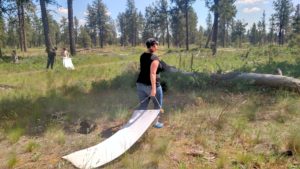 Ticks are known vectors transmitting a variety of disease-causing pathogens. It was discovered that some ticks within the Turnbull Wildlife Refuge in the area of the 30-Acre Lake Hiking Trail were carriers of the pathogen Rickettsia rickettsii that causes Rocky Mountain Spotted Fever. Due to the amount of human foot traffic this area receives, the local tick population became a topic of interest. The students designed and executed a field study to determine the effect of abiotic factors on tick population densities with the goal of discovering information that may help to predict when and where humans are most at risk of acquiring a tick that could potentially carry disease. In the field, cloth drags were used to collect questing ticks, and a sensor was used to determine temperature and humidity readings, which were recorded. At the conclusion of the field study, the students met with the instructor to determine the best method of evaluating the data. With guidance the students formatted the data and ran the necessary statistical analysis. It was discovered that ticks populations are significantly denser on the edge of the trail (p=0.0003435 when using a Wilcoxon rank sum test), and that more ticks were found at temperatures of approximately 20°C and 20-22% humidity during the spring when they are questing for hosts.
Ticks are known vectors transmitting a variety of disease-causing pathogens. It was discovered that some ticks within the Turnbull Wildlife Refuge in the area of the 30-Acre Lake Hiking Trail were carriers of the pathogen Rickettsia rickettsii that causes Rocky Mountain Spotted Fever. Due to the amount of human foot traffic this area receives, the local tick population became a topic of interest. The students designed and executed a field study to determine the effect of abiotic factors on tick population densities with the goal of discovering information that may help to predict when and where humans are most at risk of acquiring a tick that could potentially carry disease. In the field, cloth drags were used to collect questing ticks, and a sensor was used to determine temperature and humidity readings, which were recorded. At the conclusion of the field study, the students met with the instructor to determine the best method of evaluating the data. With guidance the students formatted the data and ran the necessary statistical analysis. It was discovered that ticks populations are significantly denser on the edge of the trail (p=0.0003435 when using a Wilcoxon rank sum test), and that more ticks were found at temperatures of approximately 20°C and 20-22% humidity during the spring when they are questing for hosts.
The above summaries of student research projects demonstrate the diversity of the topics and the depth to which they developed them. Overall, I was very much impressed with the amount and quality of research they have done, and with the enthusiasm and the level of interest that they showed. In the end, I believe that my class, by exposing these graduating seniors to the concepts of One Health and disease ecology, will make them better physicians and medical professionals, and help prepare them for the complex challenges that infectious diseases in our changing world holds. If at least one of them will be able to save a patient by thinking outside of the box, and consider other factors besides symptoms, even just travel history, then my efforts have already been worthwhile.

Comments